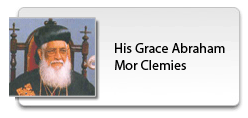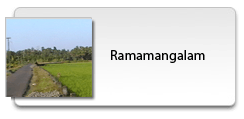Ramamangalam, Ernakulam, Kerala, India - 686663
Ramamangalam
Ramamangalam is a beautiful village in Muvattupuzha in Ernakulam district. It spreads along the bank of river Muvattupuzha. Which is the life and the sprit of the village.
Almost all the people are literate. There are many excellent schools, roads and effective telecommunication network maintaining a comfortable life style of the people.
This village is blessed to have many churches of which St.Jacob’s Kananaya Valiya Palli stands first in strength and solidarity. There is a famous temple just 1km away from this church and near to this temple that one of the greatest classical singer of all the time ‘Sri. Shadkala Govinda Maraar’ who lived in 19th century who sang for Swathi Thirunnal the great king of Travancore.
There are some schools which offer training for classical arts there by upgrading the destined enlightenment cultural consciences of the people.
Agriculture is the main source of income of the villagers. Many area keep this village green and prosperous, adding a touch of peals and worth of love, which spread the seed of religious harmony and togetherness. Among the agricultural crops vanilla the cynosure, for which this village is selected as model by the Spicer board. In addition to vanilla cultivation, rubber, coconut, pepper, nutmeg, areca, paddy etc offers substantial livelihood.
Ramamangalam is today perhaps the only village in the country where vanilla, the aromatic cash crop, is being cultivated in an organised, scientific manner. More interestingly, it was the first village in the country to be chosen as a model village by the Spices Board for cultivating vanilla, way back in 1991. And ever since, the farmers of this remote village have strived to achieve success.
Today, this cash crop has brought fortune to the simple villagers of Ramamangalam. This otherwise nondescript village now has almost 500 farmers, the highest in the country, who are fully immersed in this cultivation. The village is also the highest producer and supplier of natural vanilla in India. Of the annual production, which is around 200 tonnes, Ramamangalam's share is a mind-boggling 120 tonnes.
When in 1991, Ramamangalam decided to step into the world of vanilla cultivation, the farmers were quite unsure of its future. The main worrying factor was that they had to wait for long three years for the plant to flower. To top it all, the artificial pollination had to be done by the farmers themselves. Then in 1994, when the first crop was ready, the farmers faced another hurdle. They had no clear idea about the marketing of the crop. This led them to an essence extraction company, at Kadayiruppu, where the authorities, after a lot of persuasion, decided to accept the crop for Rs. 100 per kilogram. But the next year, the company refused to buy the crop, stating that the crop did not command a good price in the international market.
This spurred the farmers to learn how to process raw vanilla bean. They then sold it to traders from Kumily, who in turn packed the dried vanilla bean in single packets and sold it to the foreign tourists who often stopped at Kumily en route to the famous Periyar Wildlife Sanctuary. That year the farmers sold the processed bean to these traders at Rs, 1,600 per kilogram.
Credit for initiating the villagers, who earlier had a bitter experience in dealing with cash crops like rubber and cocoa. When the going seemed to be getting a bit complicated by the day, the villagers formed a collective in 1995. Christened the All Kerala Association for Vanilla Cultivation and Marketing, it has today 150 members with representation from across the State. They also bring out a very educative, bilingual booklet on vanilla regularly.
In the beginning the farmers tried this crop in their multiple crop farmlands. Only two hectares of land was earmarked exclusively for vanilla. The success and popularity of this magic crop has forced the farmers to convert nearly 500 hectares, across the country, for this crop. In Kerala alone, Vanilla is grown in 200 hectares of land, with Ramamangalam alone setting apart 75 hectares for vanilla cultivation. Apart from Kerala, many other States like Gujarat, Karnataka,Tamil Nadu and Tripura have also started vanilla farming in a big way.
The future of Vanilla is truly fascinating, since, of the total global consumption only 20 per cent is natural Vanilla and the rest is synthetic. And with the application of Vanilla in clinical treatments like aroma therapy and increased use in confectionary and beverages, the future of vanilla holds good.
For the vanilla farmers of Ramamangalam, the big break came in 1996 when AVT McCormick offered to accept raw vanilla bean at Rs. 500 per kilogram. It was a great reward and a morale booster for the villagers who had put their hart and soul into this venture. Today, with the vanilla green bean commanding a steady four-figure price per kilogram, the cash boxes of these enterprising farmers of Ramamangalam have started ringing. And, initially, if the farmers had to approach the buyers with a fervent appeal to accept their yield, today the story has taken a turn-around with all the buyers reaching this remote village twice a week to grab the harvest. In fact, it has the highest concentration of Vanilla farmers in the entire State, perhaps even the country. And for a one-day seminar held recently here more than 500 delegates participated, which was ample proof of the growing enthusiasm among the vanilla farmers.
Shadkala Govinda Marar/ Paramahamsa Govinda Das (1798-1843) The birth of Govinda Marar in 1798, who drew forth from no less a saint-singer than Tyagaraja, the immortal pancharatna materpiece 'Entharo mahanubhavulu'.
Some enthusiastic people of the locality have organised a 'Govinda Marar Smarakam' in a building adjacent to the temple and music and dance classes are conducted there. The Government of Kerala has this year announced yearly grant to it.
He leaved his village at the age of 21, carried only his tambura and edakka. He sang soulful tyanis and ashtapadis in many temples, sometimes before the deity and often sitting beneath the banyan trees, and eating whatever was brought to him by those who heard his music. The legends attached to many temples in Kerala say that Marar used to do the Kottippadi Seva (ritual singing of devotional music during the five daily poojas to the accompaniment of edakka) there for a month. The one at Ambalappuzha Krishna Temple recounts that on reaching the sanctum sanctorum, he found the stick of his edakka missing, and he played it with an ezhuthani (writing quill)supplied by a devotee. He sang the whole of the Geet Govind, and had the congregation spellbound by the flow of his music.
We do not know, where else he wandered, but eventually we find him as one of the vidwans of Maharaja Swati Tirunal's court. The Maharaja himself was utterly dedicated to music, he was a composer of no mean ability, and his court was studded with a galaxy of musicians including Vadivelu, Palghat Parameswara Bhagavathar, Meruswamy, and Kanniah.
Once Swati Tirunal wanted Marar to sing the Puraneer raga in the evening. This raga is usually rendered only for the early morning pooja. Marar had to comply, and such was the haunting quality of his alapana that the assembled had the illusion of breaking down. The appreciative Maharaja honoured Marar by bedecking his seven-stringed tambura with a vaijayanti (flag of victory). It is believed that Marar had this flag on his tambura, till he reached Benares in the last years of his short life, where he discarded it, as all pride in his musical prowess had deserted him by that time.
In spite of being soaked in music and art, the palace and its patronage did not satisfy Marar for long, for whom music had a higher aim. While at Thirivananthapuram, he had heard with deep admiration the kritis of Tyagaraja, sung by Kanniah, a direct disciple of the saint. To him Tyagaraja became a holy beacon. One Haripad Ramaswamy Bhagavatar also had learnt those kritis. Marar learnt a few such kritis from him. Soon he was all agog to have darshan of the saint at Tiruvayyaru, and in 1837 he set forth on foot, and reached the house of Tyagaraja on an ekadeshi day. The daily bhajan session led by Tyagaraja himself was on when the weary wayfarer reached the place.
When the first half of the bhajan session was over, the guest was invited to sing as was the custom. Marar had already been noticed by those assembled due to his glowingly ascetic appearance, and his unusual tambura, with the flag. Being ekadeshi, it was a day dear to Hari, and he chose his favourite Geet Govind song, 'Chandana charchitha neela kalebara', in Pantuvarali raga.
Prof.Sambamoorthy reconstructs the memorable scene from information gathered from the palm-leaf biography of the saint written by his direct disciples, Walajapet Venkitramana Bhagavathar and Tanjore Rama Rao, and from the notebook of another direct disciple, Krishnaswami Bhagavathar, thus: "He (Marar) started singing in the ati ati vilambita kala (first degree of speed). People were wondering why he started at such a dead slow tempo, but they were struck by the precision in duration between count and count. Then he sang the chosen theme in ati vilambita kala (second degree) Vilambita (third degree), Madhyama kala (fourth degree), druta kala (fifth degree) and ati druta kala (sixth degree). As he approached the fifth degree of speed, the entire audience was spellbound, and when he sang in the sixth degree of speed, Tyagaraja himself was taken aback by his laya sampat''. During the performance he was strumming the tambura with his right hand , and playing the ganjira with his left hand, holding the latter instrument in position between the toes of his right leg.
Tyagaraja immediately perceived in Marar a brilliant musician of rare genius. His spiritually evolved soul also recognised him as a mahanubhava (great soul), who like himself was seeking satchidananda, through Sangeetha. To pay tribute to the visitor, Tyagaraja asked his disciplies to sing his scintillating Pancharatna kriti 'Entharo mahanubhavulu' . The Walajapet disciples have used the word 'prasthutimpa' in Telugu, meaning 'in order to pour out praise'. The belief in Kerala is that Tyagaraja composed the kriti extempore in his spontaneous joy on hearing the spiritual and musically fantastic singing of Marar. But the version of the Walajapet disciples would have it that the kriti was already composed, and the disciples had learnt it before the arrival of Marar.
Anyway, the time of the composition of the kriti is immaterial. That Tyagaraja wanted his disciples to praise the strange ministrel by describing him as a mahanubhava, and that too through one of his outstanding kritis was in itself a recognition of not only Marar's music, but also of his personality. The latter fell at the feet of Tyagaraja with tears in his eyes, who lovingly asked Marar to stay with him. The association with Tyagaraja must have strengthened the vein of renunciation in his mind, and bidding adieu to his beloved ideal, Marar started on an indefnite itinerary.
Again he becamee an avadhoota (wandering mendicant in the process of salvation).
He finally reached the temple of Panduranga in Pandharpur, near Poona. By this
time he must have attained what his restless soul had been seeking from infancy,
and he used to sit in the temple and pour out music in a frenzy of ecstasy. He
was looked upon as a paramahamsa Govind Das by the people flocking to the
temple, a jeevanmuktha. The temple records reveal that he attained samadhi in
1843,while singing.






